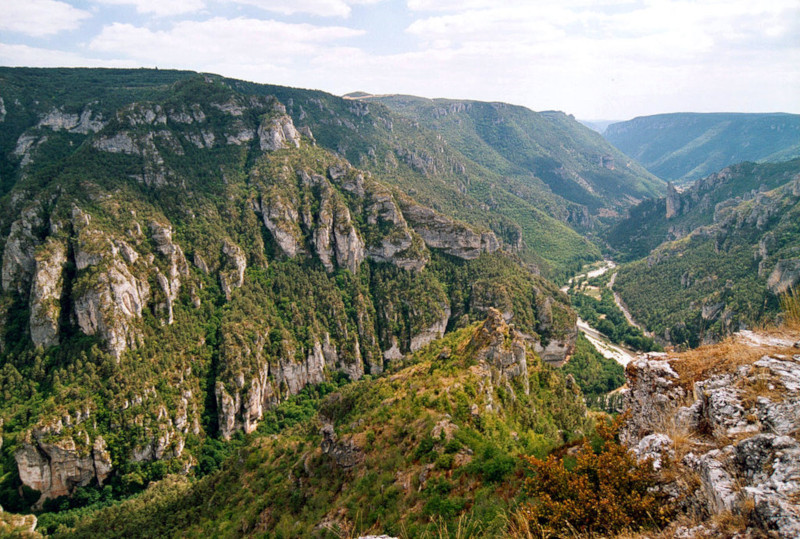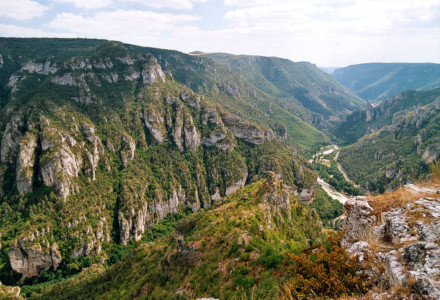
Gorges du Tarn Facts
- The deceptively simple sounding term Gorges du Tarn names a breathtaking canyon situated in a beautiful section of the Northern Hemisphere. This magnificent region of the world also stands out from similar areas for a fascinating and remarkable reason.
- That’s because it constitutes a unique location formed by an unusual combination of two separate geological forces. Due its unique positioning, this picturesque site further typically maintains a much milder climate than the rest of the surrounding region.
- This is accurate due to the fact that the beautiful area boasts a much milder winter season than the rest of the area. The summers in the area additionally tend to be somewhat warmer than those of the surrounding regions. This only adds to its appeal.
- Due to these generally comfortable conditions, the area comprising the Gorges du Tarn remains quite popular as a tourist destination. Yet, its popularity doesn’t end there. In fact, tourists and locals alike frequently enjoy numerous outdoor activities in the area.
- These include such ventures as kayaking, hiking, spelunking, and rock climbing. But the region also boasts yet another incredible attraction to many, only adding to its already ample charm. A multitude of castles, many from the Middle Ages, also draw many.
Related Articles
Gorges du Tarn Physical Description
Perhaps most notably, the gorgeous geographical feature known as the Gorges du Tarn has some truly impressive physical characteristics. That’s not simply our own personal opinion, however. This somewhat bold statement holds fully true for several reasons.
Firstly, the truly magnificent site possesses a total length measuring roughly 33 mi (53 km). Secondly, the marvelous location further has a depth that varies only moderately over its entire length. That’s because its depth ranges from 1,312 – 1,669 ft (400 – 600 m).
The stunning beauty of the Gorges du Tarn further originated with the actions of the Tarn River, itself a wonderful work of Nature. Having its source on Mount Lozere, this strongly flowing water source eventually carved out the winding path of the picturesque canyon.
Although the exact age of the site remains undetermined, estimates of its age exist. Currently, those estimates place the origin of the site in the Quaternary Period, about 2.5 million years ago. Regardless of age, though, its natural beauty constantly amazes.
Gorges du Tarn Location, Formation, and Wildlife
Perhaps not surprisingly for some, the breathtaking Gorges du Tarn formed in a region of the world already well known for its great natural beauty. That’s due to the fact that the area of the globe in which this geological wonder formed consists of the continent of Europe.
More precisely still, the magical canyon formed in the amazing area that now constitutes the country of France. Further situated in the southern portion of the country, it also happens to lie within the borders of what’s now the departments of Lozère and Aveyron.
It also bears noting that the region in which this beautiful wonder of Nature formed predominantly consists of a very pliable mineral. That’s the relatively soft sedimentary rock limestone. This formed during the Mesozoic Era, between 252 – 66 million years ago.
The comparatively soft nature of the limestone enhanced the erosive effects of the water flowing through the site, accelerating its formation. However, the region also experienced a period volcanic activity, further affecting the nature of the surrounding landscape.
The stunning beauty of the lovely Gorges du Tarn is further augmented by the marvelous flora and fauna so prevalent to the area. Added to the various plant life common to the area, however, numerous cave-dweling species also inhabit the breathtaking site.
These intriguing endemic creatures include two species of small molluscs. Several types of bats also dwell in the caves located in the gorge. Astonishingly, though, several species of vultures even inhabit the region, as well as the recently reintroduced European Beaver.
Features Sharing Its Region
Check out our other articles on 7 Spectacular Herbaceous Plants of the World, Wallace’s Flying Frog, Jeju Island, Ascension Island Parsley Fern, Bharal, Japanese Angelshark

